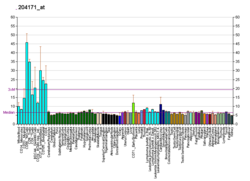P70-S6 키나세 1
P70-S6 Kinase 1리보솜 단백질 S6키나제 베타-1(S6K1)은 p70S6키나제(p70S6K, p70-S6K)로도 알려져 있으며, 인간에서 RPS6KB1 유전자에 의해 인코딩되는 효소(특히 단백질키나제)이다.[5][6]PI3키나제 경로에서 PIP3와 인지노시티드 의존키나제-1의 하류에 작용하는 세린/스로닌키나제다.[7]이름에서 알 수 있듯이, 그것의 목표 기질은 S6 리보솜 단백질이다.[8]S6의 인산화 작용은 리보솜에서 단백질 합성을 유도한다.
threonine 389에서 p70S6K의 인산화효과는 mTOR에 의한 활성화의 특징으로 사용되어 왔으며, 다양한 상황에서의 자동포기 억제와 상관관계가 있다.그러나 최근 몇 가지 연구에 따르면 p70S6K의 활동이 자가포식 증대에 보다 긍정적인 역할을 한다고 한다.[9][10]
함수
이 유전자는 S6K 계열의 세린/트레오닌 키나아제 부재를 인산화하여 S6 리보솜 단백질의 여러 잔류물을 인산화한다.이 단백질의 키나아제 활성은 단백질 합성과 세포 증식을 증가시킨다.이 유전자를 부호화하는 DNA 부위의 증폭과 이 키나아제의 과다한 압착은 일부 유방암 세포 라인에서 볼 수 있다.대체 변환 시작 사이트가 설명되었고 대체 전사 스플라이스 변형이 관찰되었지만 완전히 특성화되지는 않았다.
mTOR
p70S6 kinase는 mTOR(라파마이신의 mamalian target of rapamycin) 신호의 다운스트림 타겟으로, 특히 mTOR1은 Rictor(mTORC2)가 아닌 Raptor가 포함된 것이 특징이다.mTOR는 리소좀에서 AND게이트 유사 메커니즘을 통해 활성화할 수 있으며, 성장 인자와 바이오 가용성에 관한 신호를 통합할 수 있다.개미 분자예를 들어, 아르기닌과 류신 같은 아미노산은 mTOC1의 리소솜모집을 유발할 수 있다. 일단 리소솜에서 mTOR는 자신의 GTP-bound 상태에서 리소솜에 거주하는 작은 GTPase인 Rheb에 의해 활성화될 수 있다.Rheb GTPase 활성은 IGF 신호 전달에 의해 억제되는 업스트림 TSC 복합체에 의해 자극(따라서 mTOR 활성화 용량이 감소)된다.따라서, AND 게이트는 아미노산의 충분성에 의한 적절한 국산화 및 성장 인자에 의한 활성화로 구성된다.mTOR이 제대로 국산화·활성화되면 단백질 아나볼릭/카타볼릭 밸런스 조절에 중요한 p70S6K, 4EBP, ULK1 등 다운스트림 표적을 인산화시킬 수 있다.
물리적 운동은 mTOR, 특히 mTORC1에 의존하는 경로에서 p70S6K의 인산화(활성화)를 통해 단백질 합성을 활성화한다.이는 부하가 증가함에도 불구하고 근육량의 증가를 막기 위해 mTOR, 라파마이신 억제제를 사용함으로써 증명되었다.운동은 근육의 IGF-1 수준을 증가시켜 IGF-1/PI3K/Akt/p70S6K 신호 경로를 유도하는 것으로 나타났으며, 따라서 근육을 형성하기 위해서는 단백질 합성을 증가시켜야 한다.
임상적 유의성
S6K1 단백질의 억제 또는 부족은 세포 형성의 초기 "약속 단계"를 방해하고 지연시킴으로써 지방세포의 생성을 둔화시킨다.그 연구는 비만 치료에 영향을 미칠 수 있다.[11]
이 유전자를 부호화하는 DNA 부위의 증폭과 이 키나아제의 과다한 압착은 일부 유방암 세포 라인에서 볼 수 있다.
P70이 제안한 또 다른 방법은 근육의 연장 및 성장에 있다.P70은 발바닥근육에서 수동적인 스트레칭에 의해 인산염화된다.이것은 근육 형성에 관련된 많은 단백질 키나제들 중 하나일 것이다.[12]
비활성 상태에서 S6K1은 mTOR/Raptor에 의한 인산화 후 eIF3에 구속되고 분리된다.그러면 자유 S6K1은 eIF4B를 포함한 다수의 목표물을 인지할 수 있다.[13]
상호작용
P70-S6 Kinase 1은 다음과 상호작용하는 것으로 나타났다.
참고 항목
참조
- ^ a b c GRCh38: 앙상블 릴리스 89: ENSG00000108443 - 앙상블, 2017년 5월
- ^ a b c GRCm38: 앙상블 릴리스 89: ENSMUSG000020516 - 앙상블, 2017년 5월
- ^ "Human PubMed Reference:". National Center for Biotechnology Information, U.S. National Library of Medicine.
- ^ "Mouse PubMed Reference:". National Center for Biotechnology Information, U.S. National Library of Medicine.
- ^ Grove JR, Banerjee P, Balasubramanyam A, Coffer PJ, Price DJ, Avruch J, Woodgett JR (Nov 1991). "Cloning and expression of two human p70 S6 kinase polypeptides differing only at their amino termini". Molecular and Cellular Biology. 11 (11): 5541–50. doi:10.1128/mcb.11.11.5541. PMC 361924. PMID 1922062.
- ^ "Entrez Gene: RPS6KB1 ribosomal protein S6 kinase, 70kDa, polypeptide 1".
- ^ Chung J, Grammer TC, Lemon KP, Kazlauskas A, Blenis J. (1994). "PDGF- and insulin-dependent pp70S6k activation mediated by phosphatidylinositol-3-OH kinase". Nature. 370 (6484): 71–75. doi:10.1038/370071a0. PMID 8015612. S2CID 4352132.
{{cite journal}}: CS1 maint: 작성자 매개변수 사용(링크) - ^ Chung J, Kuo CJ, Crabtree GR, Blenis J. (1992). "Rapamycin-FKBP specifically blocks growth-dependent activation of and signaling by the 70 kd S6 protein kinases". Cell. 69 (7): 1227–1236. doi:10.1016/0092-8674(92)90643-Q. PMID 1377606. S2CID 31812410.
{{cite journal}}: CS1 maint: 작성자 매개변수 사용(링크) - ^ Datan E, Shirazian A, Benjamin S, Matassov D, Tinari A, Malorni W, Lockshin RA, Garcia-Sastre A, Zakeri Z (2014). "mTOR/p70s6k signaling distinguishes routine, maintenance-level autophagy from autophagic cell death during influenza infection". Virology. 452–453 (march 2014): 175–190. doi:10.1016/j.virol.2014.01.008. PMC 4005847. PMID 24606695.
- ^ Ci Y, Shi K, An J, Yang Y, Hui K, Wu P, Shi L, Xu C (2014). "ROS inhibit autophagy by downregulating ULK1 mediated by the phosphorylation of p53 in selenite-treated NB4 cells". Cell Death and Disease. 5 (November 2014): 1–10. doi:10.1038/cddis.2014.506. PMC 4260759. PMID 25429619.
- ^ Carnevalli LS, Masuda K, Frigerio F, Le Bacquer O, Um SH, Gandin V, Topisirovic I, Sonenberg N, Thomas G, Kozma SC (May 2010). "S6K1 plays a critical role in early adipocyte differentiation". Developmental Cell. 18 (5): 763–74. doi:10.1016/j.devcel.2010.02.018. PMC 2918254. PMID 20493810.
- ^ Van Dyke JM, Bain JL, Riley DA (Jan 2014). "Stretch-activated signaling is modulated by stretch magnitude and contraction". Muscle & Nerve. 49 (1): 98–107. doi:10.1002/mus.23880. PMID 23620271. S2CID 206294774.
- ^ Holz, Marina K.; Ballif, Bryan A.; Gygi, Steven P.; Blenis, John (2005). "mTOR and S6K1 Mediate Assembly of the Translation Preinitiation Complex through Dynamic Protein Interchange and Ordered Phosphorylation Events". Cell. 123 (4): 569–580. doi:10.1016/j.cell.2005.10.024. PMID 16286006. S2CID 11118504.
- ^ Nemazanyy I, Panasyuk G, Zhyvoloup A, Panayotou G, Gout IT, Filonenko V (Dec 2004). "Specific interaction between S6K1 and CoA synthase: a potential link between the mTOR/S6K pathway, CoA biosynthesis and energy metabolism". FEBS Letters. 578 (3): 357–62. doi:10.1016/j.febslet.2004.10.091. PMID 15589845. S2CID 9916948.
- ^ Panasyuk G, Nemazanyy I, Zhyvoloup A, Bretner M, Litchfield DW, Filonenko V, Gout IT (Oct 2006). "Nuclear export of S6K1 II is regulated by protein kinase CK2 phosphorylation at Ser-17". The Journal of Biological Chemistry. 281 (42): 31188–201. doi:10.1074/jbc.M602618200. PMID 16895915.
- ^ Holz MK, Ballif BA, Gygi SP, Blenis J (Nov 2005). "mTOR and S6K1 mediate assembly of the translation preinitiation complex through dynamic protein interchange and ordered phosphorylation events". Cell. 123 (4): 569–80. doi:10.1016/j.cell.2005.10.024. PMID 16286006. S2CID 11118504.
- ^ Ali SM, Sabatini DM (May 2005). "Structure of S6 kinase 1 determines whether raptor-mTOR or rictor-mTOR phosphorylates its hydrophobic motif site". The Journal of Biological Chemistry. 280 (20): 19445–8. doi:10.1074/jbc.C500125200. PMID 15809305.
- ^ Ha SH, Kim DH, Kim IS, Kim JH, Lee MN, Lee HJ, Kim JH, Jang SK, Suh PG, Ryu SH (Dec 2006). "PLD2 forms a functional complex with mTOR/raptor to transduce mitogenic signals". Cellular Signalling. 18 (12): 2283–91. doi:10.1016/j.cellsig.2006.05.021. PMID 16837165.
- ^ Hara K, Maruki Y, Long X, Yoshino K, Oshiro N, Hidayat S, Tokunaga C, Avruch J, Yonezawa K (Jul 2002). "Raptor, a binding partner of target of rapamycin (TOR), mediates TOR action". Cell. 110 (2): 177–89. doi:10.1016/S0092-8674(02)00833-4. PMID 12150926. S2CID 6438316.
- ^ Nojima H, Tokunaga C, Eguchi S, Oshiro N, Hidayat S, Yoshino K, Hara K, Tanaka N, Avruch J, Yonezawa K (May 2003). "The mammalian target of rapamycin (mTOR) partner, raptor, binds the mTOR substrates p70 S6 kinase and 4E-BP1 through their TOR signaling (TOS) motif". The Journal of Biological Chemistry. 278 (18): 15461–4. doi:10.1074/jbc.C200665200. PMID 12604610.
- ^ Chiang GG, Abraham RT (Jul 2005). "Phosphorylation of mammalian target of rapamycin (mTOR) at Ser-2448 is mediated by p70S6 kinase". The Journal of Biological Chemistry. 280 (27): 25485–90. doi:10.1074/jbc.M501707200. PMID 15899889.
- ^ Holz MK, Blenis J (Jul 2005). "Identification of S6 kinase 1 as a novel mammalian target of rapamycin (mTOR)-phosphorylating kinase". The Journal of Biological Chemistry. 280 (28): 26089–93. doi:10.1074/jbc.M504045200. PMID 15905173.
- ^ Isotani S, Hara K, Tokunaga C, Inoue H, Avruch J, Yonezawa K (Nov 1999). "Immunopurified mammalian target of rapamycin phosphorylates and activates p70 S6 kinase alpha in vitro". The Journal of Biological Chemistry. 274 (48): 34493–8. doi:10.1074/jbc.274.48.34493. PMID 10567431.
- ^ Long X, Lin Y, Ortiz-Vega S, Yonezawa K, Avruch J (Apr 2005). "Rheb binds and regulates the mTOR kinase". Current Biology. 15 (8): 702–13. doi:10.1016/j.cub.2005.02.053. PMID 15854902. S2CID 3078706.
- ^ Toral-Barza L, Zhang WG, Lamison C, Larocque J, Gibbons J, Yu K (Jun 2005). "Characterization of the cloned full-length and a truncated human target of rapamycin: activity, specificity, and enzyme inhibition as studied by a high capacity assay". Biochemical and Biophysical Research Communications. 332 (1): 304–10. doi:10.1016/j.bbrc.2005.04.117. PMID 15896331.
- ^ Saitoh M, Pullen N, Brennan P, Cantrell D, Dennis PB, Thomas G (May 2002). "Regulation of an activated S6 kinase 1 variant reveals a novel mammalian target of rapamycin phosphorylation site". The Journal of Biological Chemistry. 277 (22): 20104–12. doi:10.1074/jbc.M201745200. PMID 11914378.
- ^ Kim DH, Sarbassov DD, Ali SM, King JE, Latek RR, Erdjument-Bromage H, Tempst P, Sabatini DM (Jul 2002). "mTOR interacts with raptor to form a nutrient-sensitive complex that signals to the cell growth machinery". Cell. 110 (2): 163–75. doi:10.1016/S0092-8674(02)00808-5. PMID 12150925. S2CID 4656930.
- ^ Edinger AL, Linardic CM, Chiang GG, Thompson CB, Abraham RT (Dec 2003). "Differential effects of rapamycin on mammalian target of rapamycin signaling functions in mammalian cells". Cancer Research. 63 (23): 8451–60. PMID 14679009.
- ^ Leone M, Crowell KJ, Chen J, Jung D, Chiang GG, Sareth S, Abraham RT, Pellecchia M (Aug 2006). "The FRB domain of mTOR: NMR solution structure and inhibitor design". Biochemistry. 45 (34): 10294–302. doi:10.1021/bi060976+. PMID 16922504.
- ^ Takahashi T, Hara K, Inoue H, Kawa Y, Tokunaga C, Hidayat S, Yoshino K, Kuroda Y, Yonezawa K (Sep 2000). "Carboxyl-terminal region conserved among phosphoinositide-kinase-related kinases is indispensable for mTOR function in vivo and in vitro". Genes to Cells. 5 (9): 765–75. doi:10.1046/j.1365-2443.2000.00365.x. PMID 10971657. S2CID 39048740.
- ^ Burnett PE, Barrow RK, Cohen NA, Snyder SH, Sabatini DM (Feb 1998). "RAFT1 phosphorylation of the translational regulators p70 S6 kinase and 4E-BP1". Proceedings of the National Academy of Sciences of the United States of America. 95 (4): 1432–7. doi:10.1073/pnas.95.4.1432. PMC 19032. PMID 9465032.
- ^ Sarbassov DD, Sabatini DM (Nov 2005). "Redox regulation of the nutrient-sensitive raptor-mTOR pathway and complex". The Journal of Biological Chemistry. 280 (47): 39505–9. doi:10.1074/jbc.M506096200. PMID 16183647.
- ^ Richardson CJ, Bröenstrup M, Fingar DC, Jülich K, Ballif BA, Gygi S, Blenis J (Sep 2004). "SKAR is a specific target of S6 kinase 1 in cell growth control". Current Biology. 14 (17): 1540–9. doi:10.1016/j.cub.2004.08.061. PMID 15341740. S2CID 12838409.
- ^ Peterson RT, Desai BN, Hardwick JS, Schreiber SL (Apr 1999). "Protein phosphatase 2A interacts with the 70-kDa S6 kinase and is activated by inhibition of FKBP12-rapamycinassociated protein". Proceedings of the National Academy of Sciences of the United States of America. 96 (8): 4438–42. doi:10.1073/pnas.96.8.4438. PMC 16350. PMID 10200280.
- ^ Bishop JD, Nien WL, Dauphinee SM, Too CK (Aug 2006). "Prolactin activates mammalian target-of-rapamycin through phosphatidylinositol 3-kinase and stimulates phosphorylation of p70S6K and 4E-binding protein-1 in lymphoma cells". The Journal of Endocrinology. 190 (2): 307–12. doi:10.1677/joe.1.06368. PMID 16899564.
- ^ a b Panasyuk G, Nemazanyy I, Filonenko V, Gout I (May 2008). "Ribosomal protein S6 kinase 1 interacts with and is ubiquitinated by ubiquitin ligase ROC1". Biochemical and Biophysical Research Communications. 369 (2): 339–43. doi:10.1016/j.bbrc.2008.02.016. PMID 18279656.









